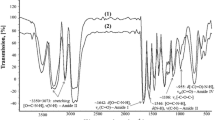Abstract
The investigation of the features of the formation of interpenetrating polymer networks (IPNs) based on cross-linked polyurethane and organic-inorganic copolymer (OIC) based on hydroxyethyl methacrylate (HEMA) and titanium isopropoxide (Ti(OPri)4) was carried out using the IR spectroscopy method. It has been demonstrated that during the synthesis of organic-inorganic IPNs (OI IPNs), three-dimensional cross-linked structures with the inclusion of (-TiO2-) fragments in the polymer chain of poly(hydroxyethyl methacrylate) are formed. The examinations of the viscoelastic properties and thermal stability of organic-inorganic IPNs by dynamic mechanical (DMA) and thermogravimetric analysis (TGA) showed that the value of M c decreases with an increase in the content of (-TiO2-) fragments in OI IPN; in addition, the thermal stability of the obtained hybrid OI IPNs increases significantly compared to the parent systems.
Similar content being viewed by others
References
Bonilla, G., Martinez, M., Mendoza, A.M., and Widmaier, J.-M., Ternary interpenetrating networks of polyurethane-poly(methyl methacrylate)-silica: Preparation by the sol-gel process and characterization of films, Eur. Polym. J., 2006, vol. 42, pp. 2977–2986.
Naghash, H.J., Interpenetrating polymer networks based on poly(styrene-co-butyl-acrylate-co-hydroxyethylmethacrylate) and SiO2, J. Appl. Polym. Sci., 2011, vol. 122, no. 1, pp. 722–728.
Kameneva, O., Kuznestov, A.I., Smirnova, L.A., Rozes, L., Sanchez, C., Alexandrov, A., Bityurin, N., Chhor, K., and Kanaev, A., New photoactive hybrid organicinorganic materials based on titanium-oxo-PHEMA nanocomposites exhibiting mixed valence properties, J. Mater. Chem., 2005, vol. 15, pp. 3380–3383.
Wu, Ch.-S., In situ polymerization of titanium isopropoxide in polycaprolactone: Properties and characterization of the hybrid nanocomposites, J. Appl. Polym. Sci., 2004, vol. 92, no. 3, pp. 1749–1757.
Sanchez, C., Soler-Illia, A.A., Ribot, F., Lalot, T., Mayer, C.R., and Cabuil, V., Designed hybrid organicinorganic nanocomposites from functional nanobuilding blocks, Chem. Mater., 2001, vol. 13, no. 10, pp. 3061–3083.
Huang, S.L., Chin, W.K., and Yang, W.P., Structural characteristics and properties of silica/poly(2-hydroxyethylmethacrylate) (PHEMA) nanocomposites prepared by mixing colloidal silica or tetraethyloxysilane (TEOS) with PHEMA, Polymer, 2005, vol. 46, pp. 1865–1877.
Rozenberg, B.A., Gur’eva, L.L., Dzhavadyan, E.A., and Estrina, G.A., Interchain exchange reactions in the anionic polymerization of (meth)acrylates containing groups with mobile hydrogen atoms, Polym. Sci., Ser. A, 2003, vol. 45, no. 9, pp. 840–846.
Bradley, D.C. and Millger, H.J., Thermochemistry of metal alkoxides: Part 2. Heats of formation of some titanium alkoxides, Trans. Faraday Soc., 1966, vol. 62, pp. 2374–2381.
Dechant, J., Danz, R., Kimmer, W., and Schmolke, R., Ultrarot spektroskopische Untersuchungen an Polymeren, Berlin: Akademie, 1972.
Zhou, H., Chen, Y., Fan, H., Shi, H., Luo, Zh., and Shi, B., Water vapor permeability of the polyurethane/TiO2 nanohybryd membrane with temperature sensitivity, J. Appl. Polym. Sci., 2008, vol. 109, no. 5, pp. 3002–3007.
Hourston, D.J., Schäfer, F.-U., Gradwel, M.H.S., and Song, M., TMXDI-based poly(ether urethane)/polystyrene interpenetrating polymer networks: 2. T g behaviour, mechanical properties, and modulus-composition studies, Polymer, 1998, vol. 39, no. 23, pp. 5609–5617.
Trabelsi, S., Janke, A., Hässler, R., Zafeiropoulos, N.E., Fornasieri, G., Bocchini, S., Rozes, L., Stamm, M., Gérard, J.-F., and Sanchez, C., Novel organo-functional titanium-oxo-cluster-based hybrid materials with enhanced thermomechanical and thermal properties, Macromolecules, 2005, vol. 38, pp. 6068–6078.
Markin, A.V., Yakimovich, N.O., Smirnova, L.A., and Smirnova, N.N., Calorimetric investigation of organic-inorganic copolymers of ethylene glycol methacrylate and titanium dioxide, Polym. Sci., Ser. B, 2008, vol. 50, nos. 5–6, pp. 124–127.
Author information
Authors and Affiliations
Corresponding author
Additional information
Original Russian Text © T.T. Alekseeva, I.S. Martynyuk, N.V. Babkina, G.Ya. Menzheres, 2014, published in Fizika i Khimiya Stekla.
Published from the Proceedings of the II International Conference of the CIS “Sol-Gel Synthesis and Study of Inorganic Compounds, Hybrid Functional Materials, and Disperse Systems,” held in Sevastopol’, Ukraine, on September, 18–20, 2012.
Rights and permissions
About this article
Cite this article
Alekseeva, T.T., Martynyuk, I.S., Babkina, N.V. et al. Interpenetrating polymer networks based on polyurethane and organic-inorganic copolymer. Glass Phys Chem 40, 17–25 (2014). https://doi.org/10.1134/S1087659614010039
Published:
Issue Date:
DOI: https://doi.org/10.1134/S1087659614010039




